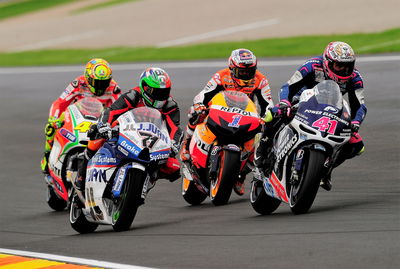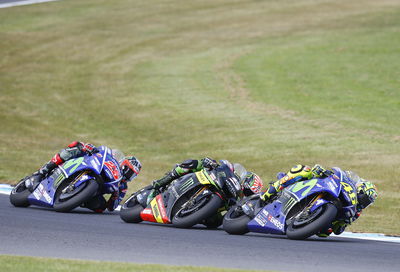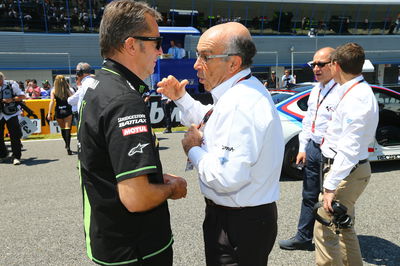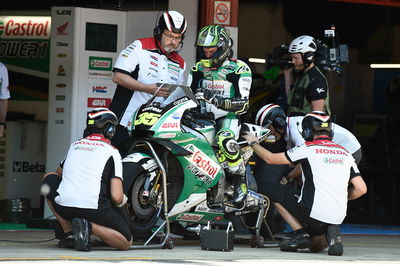'Everybody laughed', but CRT started MotoGP rules revolution
On November 18, in Valencia, Tech3 will take part in its final MotoGP race with Yamaha machinery, ending a 20-year relationship between the French team and Japanese manufacturer.
Two days later, Tech3 will start a new association with KTM, while the Sepang International Circuit takes over as Yamaha's satellite team.
"I've been extremely happy for 20 years with Yamaha," said team boss Herve Poncharal. "This is completely honest from me. I've said it before and I'll say it again; it's been the best years of my professional life.

On November 18, in Valencia, Tech3 will take part in its final MotoGP race with Yamaha machinery, ending a 20-year relationship between the French team and Japanese manufacturer.
Two days later, Tech3 will start a new association with KTM, while the Sepang International Circuit takes over as Yamaha's satellite team.
"I've been extremely happy for 20 years with Yamaha," said team boss Herve Poncharal. "This is completely honest from me. I've said it before and I'll say it again; it's been the best years of my professional life.
"I've met incredibly good people. We've been world champion with OJ [Olivier Jacque]. We did all that we've done in the MotoGP class and - through Yamaha - had the possibility to work with riders like Ben Spies, Colin Edwards… It was great.
"And even though we don't have the latest spec bike, look at what Johann has been doing. So I would be stupid to complain and you can't say we don't have good support.
"But I have had an offer [from KTM] that was really exciting, because I like the risk, the challenge! This is a new adventure for me.
"But that doesn't mean I'm unhappy with Yamaha and I'm happy for the guys who will be the next Yamaha supported team, because you can see the level of this bike."

Satellite teams, factory bikes
If there was an area of potential friction between Tech3 and Yamaha, it was over Yamaha's refusal to match Honda and Ducati by giving one latest spec machine to a deserving satellite rider.
Tech3 tried, but it simply wasn't an option. However Yamaha's stance could change under the terms of its new agreement with SIC, although - like the riders - that is still to be confirmed.
"If it [factory M1s at a satellite team] is happening with the new entry, I'm happy for them. I'm not bitter," Poncharal said.
"We've been trying with a lot of riders - Colin Edwards, Ben Spies, Andrea Dovizioso, Cal Crutchlow, Johann Zarco… and it was always, 'no way'. Because Yamaha's policy is a factory team with the latest [bikes] and a satellite team with the previous year's bikes.
"I accepted it. I did try and some riders like Ben, Dovi and Cal also pushed through the own management but it was always [no]. Even Pol Espargaro, who was contracted to the factory."
'Everything is coming into place'
Whether the new SIC team get 2019 Yamahas remains to be seen, but either way the number of satellite teams running the latest MotoGP machinery will at least double next season.
Tech3 will be the only independent team with two such entries, via its new deal with KTM, while Pramac (Jack Miller) and LCR (Cal Crutchlow) will continue to get one 2019 machine from Ducati and Honda respectively.
The trend illustrates how the balance of power has shifted more towards the satellite teams, due to a combination of 'equalising' technical rules and a realisation by the factories that having a satellite team contributes to their success.
In the past, manufacturers often gave the impression that leasing (for a fee of several million euros each) even year-old machines was an altruistic act.
"It was like having a satellite operation was a weight, but now things look like they are changing," said Poncharal, who is also President of the teams' association IRTA. "Maybe they understand, 'having a satellite operation is helping us in this, this, this and this'.
"Suzuki is trying - maybe not for next year - but they clearly want [a satellite team]. They have decided in 2019 or 2020 they will have a satellite operation. Even Aprilia are thinking we should have it. KTM has decided. Ducati have plenty. HRC have, Yamaha will have.
"With four bikes you can prepare for the future by picking up some young riders, look at their level and also if they are fast - as Zarco and Folger were last year - you can use also their data, their feedback, their comments, because four comments is better than two. You learn more and you deliver quicker. It's in the interest of everyone.
"So everything is slowly coming into place and it's a bit like what we imagined would happen. And I think more and more each manufacturer understands the need to have an 'official' satellite operation, using the latest bikes."

'A bit like we imagined'
When Poncharal says 'it's a bit like we imagined', he's referring to a set of rule changes stretching back over ten years that - viewed in isolation - were often derided.
Dorna's first move on the MotoGP chess board was a single tyre supplier in 2009, but it's most controversial was the introduction of 'CRT' (Claiming Rule Team) machines in 2012.
Triggered by plummeting grid numbers following the financial crisis and a lack of effective solutions from the manufacturers - just twelve prototypes remained on the grid, two factory and two satellite from Honda, Yamaha and Ducati - the CRT initiative allowed superbike-powered machines to be run by independent teams.
That restored grid numbers to 21 entries, meeting the immediate target of enough bikes to run a world championship.
But to give the CRTs a chance of being within sight of the factory prototypes, a series of technical concessions were introduced for the first time in grand prix. These gave the CRTs more fuel and engine changes. A softer tyre would follow in 2013.
While CRT is long forgotten, technical concessions continue and are credited with helping foster close racing throughout the grid and ensuring no serious project falls hopelessly behind.
In other words, now results-based and issued by brand, the current concessions (more private testing, engine changes and engine development) indirectly help compensate for the difference in budgets between the various manufacturers.
The second year of CRT (2013) saw Dorna hire Magneti-Marelli to create a standard ECU system, aimed at providing the CRT bikes with a high-level electronics system, to reduce the performance gap to the factory prototypes.
It was also the first step towards a single ECU system for all competitors, which became a reality from 2016. By then, CRT and its 'Open class' successor (2014-2015) had done their job and disappeared.
So it was CRT that introduced both technical concessions and the start of a single ECU for the MotoGP class. But having two different groups of machines, Factory-Satellite and CRT/Open, racing within one championship was far from ideal.
The 'checkmate' occurred in 2014, when Ducati attempted to switch their official team from Factory-to-Open class rules. It was the moment the MotoGP organisers had been waiting for.
"Eventually we hope the factories will have their hand forced into saying, 'okay, we'll have to go with [Open] rules because it's the most competitive'," commented Race Director Mike Webb, one week before Ducati's Open announcement.
Closely involved in supplying Open bikes to satellite teams, Ducati knew a tipping point had been reached in terms of which set of rules was more competitive. Eligibility for the Open class simply depended on use of the standard ECU system, which Ducati could help develop anyway.
Under the new leadership of Gigi Dall’Igna, Ducati also had little to lose. The factory had been winless since 2010, with every MotoGP victory from 2011-2014 shared between Honda and Yamaha.
But the Japanese factories were left disgruntled at what they saw as an abuse of the 'privateer' spirit of the Open class rules and also feared a Ducati advantage. Ultimately, they had been outmanoeuvred by not insisting on replacement wording to deter a Factory-to-Open move when the 'claiming rule' was dropped and Open class created at the end of 2013.
The various parties thrashed out a compromise that saw an interim set of 'Factory 2' rules (Factory with results-based Concessions) - which would apply to Ducati, then later Suzuki and Aprilia, for 2014-2015 - leading up to the introduction of 'unified' ECU software for all in 2016.
Webb confirmed that having the full MotoGP grid racing under the same Open-based technical rules had always been the final target, but lamented it had taken so long:
"It has been incremental. We've had a lot of interim years, where we are trying to get a final rule change done and ideally it should have been done at once in 2012 [when CRT was created]. It is not until [the single ECU in 2016] that we can get the whole job done."
The 2016 season began with a grid of 21 full prototypes from Honda, Yamaha, Ducati, Suzuki, Aprilia and ended with the MotoGP debut of KTM.
The season - which also saw Michelin replacing Bridgestone as tyre supplier - produced the first MotoGP victories for satellite riders since 2006, by Jack Miller and Cal Crutchlow and a record nine different race winners from four manufacturers (Honda, Yamaha, Ducati and Suzuki).
Click Below for Page 2












